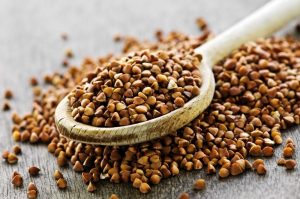
Buckwheat or beech wheat gets its name from its triangular seeds, which resemble the much larger seeds of the beech nut, and the fact that it is used like wheat is a non-glutinous pseudo-cereal. It is similar to sunflower seed, with a single white seed inside a hard dark brown/black outer hull. Buckwheat is commonly grown for its black or gray triangular seeds. It can also be grown as a green manure crop, a companion crop, a cover crop, a source of buckwheat honey, and as a pharmaceutical plant yielding routine.
Related project:- KUTTU (BUCKWHEAT) SEED DEHULLING)
Buckwheat grain is grown mainly for human consumption and as animal feed, although it can also be used as a vegetable, a green manure crop, as a smother crop to crow out weeds and as a source of buckwheat honey. Demand for buckwheat grain is solid and steadily improving. The primary demand has come from the export market, but even in the India, U.S. buckwheat use has risen, in part due to multi-grain baked foods.
Production of Buckwheat
Buckwheat is a relatively low input crop that has relatively high yields even in marginal soil. Because it adds nutrients to the soil, it makes a good cover crop or rotational crop. While the environmental benefits of buckwheat are difficult to measure, some studies have been done to show that it is cost effective as a double crop.
Buckwheat grows quickly, with a 30-day maturity rate that allows it to kill off most competing weeds. Due to its fast growth, it is a good candidate for a catch crop when others have failed, and it also fits well into rotations. In addition, it is economical to produce because it requires no pesticides and few herbicides, draws phosphorus efficiently from the soil, and needs less nitrogen. While it requires little care from sowing to harvest, good seedbed preparation is important. Buckwheat is used as a cover crop or a rotational crop because it can grow in even poor soil; it also is often used to prepare organic crop soil because it can eliminate weeds. It can add up to 3,000 pounds of organic matter per acre back into the soil when tilled.
Related books:- Cereal Food, Cereals And Cereal Products Processing Industry
Market and Demand of Buckwheat in India
The global buckwheat market is anticipated to grow at a moderate rate to reach a significant value by the end of the year of assessment. The buckwheat market has been experiencing steady growth during the 2012-2016 timeline. It is projected to grow at a value CAGR of 4.2% throughout the period of assessment, to reach a market value of around US$ 1.8 billion by end of 2027 from a market valuation of about US$ 1.1 Bn in 2017. The research study portrays a complete picture of the global market for buckwheat and covers forecast analysis for a period of 10 years, starting from 2017 till 2027. Aspects such as increasing consumption of buckwheat in food and beverage sector, increasing innovations in food resulting in rising consumption of buckwheat, increasing consumer focus towards organic food and increasing need for gluten free products are expected to fuel the growth of the global market for buckwheat. Moreover, the “on-the-go consumption” pattern is increasing the traction of RTC (ready to cook) /RTE (ready to eat) healthy meals in the food industry.
Related videos:- Processed Food Industry
Conclusion
The Niir Project Consultancy Services (NPCS) provide detailed project reports, Books, Business Plan for Manufacturing Plant, Start-up Ideas, and Business Ideas for Entrepreneurs, etc. You can also get the detailed project report on “Buckwheat Dehulling” all the project reports give reliable data on analysis of market, confirming availability of various necessities such as plant & machinery, raw materials to forecasting the financial requirements.
Noo_Art21